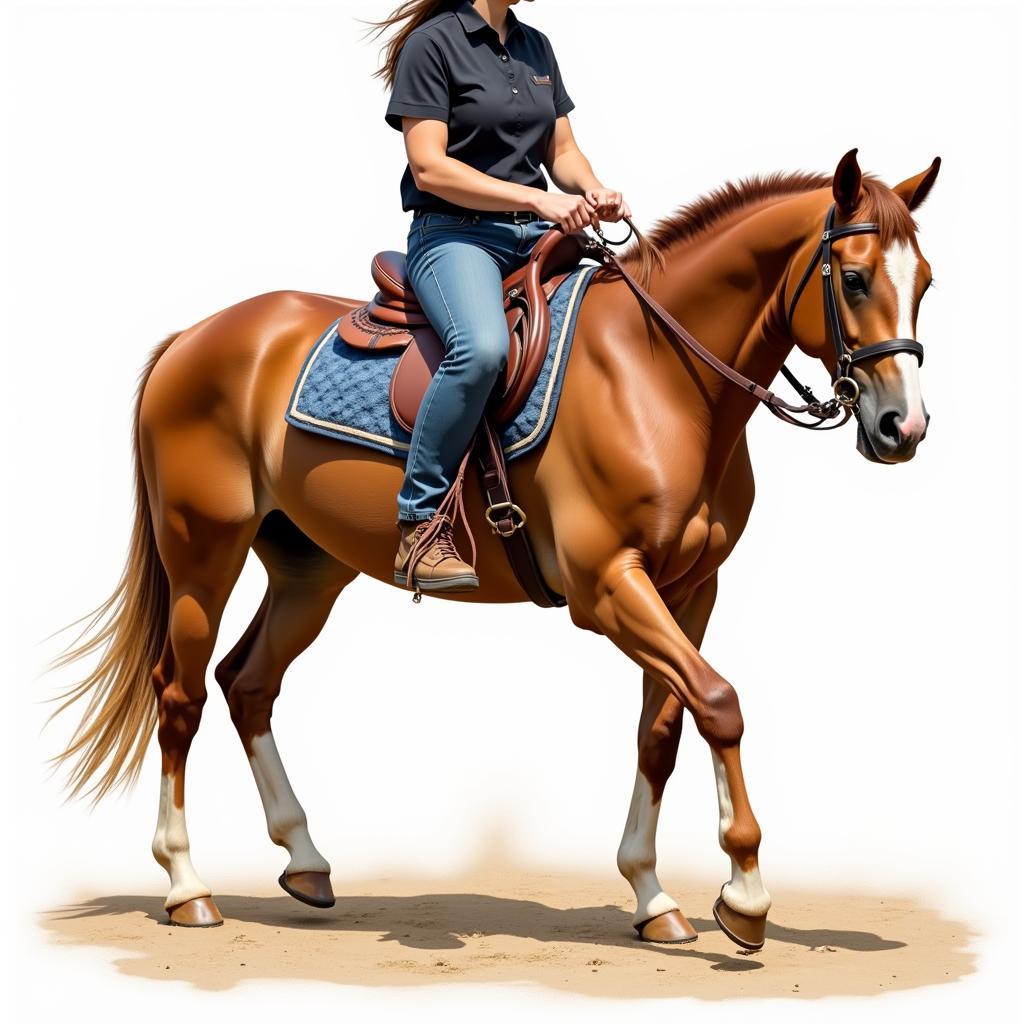Spurs for horses are tools used in riding to refine communication between horse and rider. They are not instruments of punishment, but rather aids that can enhance cueing and encourage specific responses. This article will explore the proper use, types, and potential misconceptions surrounding Spurs Horses.  Horse rider correctly using spurs
Horse rider correctly using spurs
Types of Spurs for Horses
There’s a surprising variety in the world of spurs horses. From the classic Prince of Wales spur to the more intricate ball spurs, each design has its purpose. Some common types include:
- Prince of Wales Spurs: A classic design featuring a small, rounded rowel.
- Ball Spurs: These spurs have a small, rotating ball at the end, which can be less severe than a rowel.
- Rollerball Spurs: Similar to ball spurs, these feature a larger, freely rotating roller, offering a smoother contact.
- Dummy Spurs: These are spurs without rowels or balls, primarily used for riders learning to use spurs correctly.
Choosing the right type of spur depends on both the horse’s sensitivity and the rider’s experience.
The Correct Use of Spurs Horses
Using spurs horses effectively relies heavily on proper leg position and timing. Spurs are not meant to be used constantly but applied with precision and only when necessary to reinforce other aids. Incorrect use can lead to confusion, fear, and even injury for the horse. horses hocks can be particularly sensitive, so careful spur placement is crucial.
Leg Position and Timing
Effective spur use begins with a secure and balanced seat. The rider’s leg should hang naturally with the heel slightly lowered. The spur should be applied just behind the girth area, with a light and momentary touch. Overuse or aggressive application can desensitize the horse or cause it to react defensively.
Common Misconceptions About Spurs Horses
Spurs often carry a negative connotation, often perceived as tools of punishment. However, when used correctly, they are simply another tool in the rider’s arsenal for refined communication.
Spurs Are Not for Punishment
Spurs should never be used out of frustration or anger. Their purpose is to refine cues, not inflict pain. If a horse is consistently unresponsive to other aids, the issue likely lies in the rider’s technique or the horse’s training, not the absence of spurs.
Experience Matters
Riders new to using spurs should seek guidance from experienced trainers. spurs for horse riders can be beneficial tools, but improper use can be detrimental.
Choosing the Right Spurs Horses
Selecting appropriate spurs requires careful consideration of both horse and rider. A horse with sensitive skin might benefit from rollerball spurs, while a more seasoned horse might respond well to a Prince of Wales spur. horse spurs and straps should also be chosen for proper fit and comfort.
Spur Length and Rowel Type
The length of the spur’s neck and the type of rowel or ball play a significant role in its severity. Shorter necks are generally milder, while longer necks offer greater leverage. Similarly, smoother rowels or balls are less severe than sharp or pointed ones. horse spurs and spur straps should be checked regularly for wear and tear, as damaged equipment can injure the horse.
“Choosing the right spur is like selecting the right brush for an artist. The correct tool allows for finer detail and more nuanced expression,” says renowned equestrian coach, Sarah Miller.
Spurs Horses: A Tool for Refined Communication
Spurs, when used correctly, can be valuable tools for refining communication between horse and rider. They are not meant for punishment but rather to enhance cueing and encourage desired responses.
In conclusion, spurs horses are an aid to enhance communication, not inflict pain. Proper use, selection, and understanding of their purpose are crucial for both horse and rider. Remember, responsible riding prioritizes the horse’s well-being and clear communication.
FAQs:
- Are spurs cruel? No, when used correctly spurs are not cruel. They are a tool for refined communication.
- When should I start using spurs? Only after you have developed a secure seat and independent leg aids. Consult with an experienced trainer.
- What type of spur is best for beginners? Dummy spurs or ball spurs are often recommended for beginners.
- How do I know if my spurs fit correctly? The spur should lie close to the boot without pinching or rubbing.
- Can spurs damage my horse? Yes, if used incorrectly or excessively, spurs can cause pain and injury.
- What are some alternatives to spurs? A riding crop can be used as an alternative, but should also be used with care.
- Are spurs necessary for all disciplines? No, spurs are not necessary for all disciplines and their use varies.
You may also be interested in these related articles on our website:
Need more help? Contact us at Phone Number: 0772127271, Email: [email protected] Or visit our address: QGM2+WX2, Vị Trung, Vị Thuỷ, Hậu Giang, Việt Nam. We have a 24/7 customer service team.